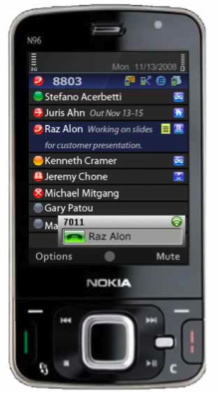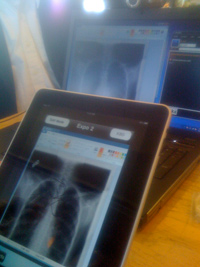 Dual mode WiFi-cellular devices have improved a great deal in the past few years. Vendors like BlackBerry, Nokia and HTC have improved the hardware performance with faster processors, higher resolution screens, more on-board storage, smaller dimensions and most important to many users – longer battery life. Some have even gone so far as to allow third party software developers to leverage their own intellectual properties and create remarkable (certainly by today’s standards) experiences for users. Agito Networks, of Santa Clara California has pushed the typical vendor improvements to create one of these compelling experiences.
Dual mode WiFi-cellular devices have improved a great deal in the past few years. Vendors like BlackBerry, Nokia and HTC have improved the hardware performance with faster processors, higher resolution screens, more on-board storage, smaller dimensions and most important to many users – longer battery life. Some have even gone so far as to allow third party software developers to leverage their own intellectual properties and create remarkable (certainly by today’s standards) experiences for users. Agito Networks, of Santa Clara California has pushed the typical vendor improvements to create one of these compelling experiences.
Founded in 2006 by former Cisco employees, the company has managed in three short years to develop a server and client software product portfolio, an extensive global channel partner network covering North America, Europe and India and are doubling their revenues quarter over quarter despite the worst recession in recent memory.
 Router leverages intimate understanding of leading WiFi controllers and networks
Router leverages intimate understanding of leading WiFi controllers and networks
At the heart of the implementation is the Agito RoamAnywhere Mobility Router. This 1U server integrates into the market leading IP PBX environments from vendors such as Cisco, Avaya, Nortel, ShorTel, Alcatel-Lucent, Shoretel, Microsoft OCS and others, open source projects such as Asterisk to provides SIP-based shared line appearance (aka simultaneous ring) functionality. Calls initiated from outside the enterprise are simultaneously processsed by the IP PBX to ring the IP deskphone and pass the session request to the Agito router which then forwards the request to the appropriate WiFi-attached softphone client on the users’ mobile device, or passes the call back to the IP PBX to ring the appropriate mobile telephone number if the target user is out-of-WiFi coverage or has a cellular-only smartphone or feature phone. For digital PBX implementations, the presence of a digital-IP gateway between the PBX and the Agito router enables many of the same functionalities, but not necessarily all.
Significantly, the Agito router, like all SIP registrars keeps track of their authenticated endpoints status – onhook, offhook, in-WiFi-range, out-of-WiFi-range, authenticated or not – and appropriately reports that to the IP PBX if necessary or to the appropriate Presence engine for the company.
Administrators can engage the onboard Tomcat server to access AJAX-based mashups of service availability, call logs, operating parameters and service activation for realtime monitoring of usage and troubleshooting workflows. Since the server knows the call frequencies, call types and with appropriate details of the wireless operator plans, an administrator can even calculate their enterprise ROI for an implementation.
Client – do no harm
Agito has paid particular attention to the WiFi operation of their devices. The founders had significant experience in Cisco (and other vendors) wireless product group (meaning WiFi) and made good use of that engineering expertise to really get at the heart of the dual mode experience. First in their philosphy was a kind of ‘do no harm’ sensitivity to User Interface. Their client goal was to avoid introducing any new UI requirements or interactions. They decided that all of their functionality was to be delivered behind dialers, IM clients and address books that were already existing on the mobile device. Of course, this is a big challenge for virtually every other mobile UC, who often publish their logos, introduce new kinds of work flows, and if necessary introduce unique dialers for each ‘side’ of the dual mode device. Having two experiences in a dual mode device is not the same as one experience in a dual mode device.
Mid-call Feature Activation. For both dual mode and cellular-only devices, call manipulation features are supported using DTMF patterns.
Security. The Agito clients are downloaded over-the-air to devices. They include an X.509 certificate to enable 2-way SSL tunnels for really secure communications when outside the enterprise (or optionally inside as well). When the SSL is enabled, both call control information and voice media are encrypted with the traffic encrypted/decrypted at the Mobility Router and at the mobile device. When SSL is disabled and the WiFi-specific WPA2/WPA encryption is used over the WiFi portion of the communications path (between the mobile device and the access point), voice media flows directly between endpoints without traversing the Mobility Router.
Engaging the SSL feature on a routine basis may have engineering consequences on the Mobility Router, suppressing the maximum number of simultaneous sessions, since the Mobility Router is engaged in terminating the SSL session. It may also have effects on the battery life of the mobile device, but if used sparingly, the added benefit of strong encryption can be a practical requirement in select industries and applications where eavesdropping could have national security, patient privacy or serious industrial espionage implications.
[inset side=right]Agito paid careful attention to WiFi interactions.[/inset] Handoffs. The WiFi expertise allowed Agito to significantly enhance the typical WiFi-cellular handoff experience. In the first generation implementations of handoff, the client monitors the degrading WiFi signal strength and initiates a call handover to the cellular network. This is a distress-based approach and often results in failed handovers since the user walks out of range before the session can be properly handed over.
Agito is able to rely on location-based information that is not solely based on signal strength. The cellular and WiFi spectrum attributes of the doorways in an enterprise are measured and noted in a site survey as part of the initial implementation. Then, whenever a user’s location profile suggests movement closer to the door, the handover process can begin before the degradation occurs assuring a higher probability of successful and seamless handover – measured at <100 miliseconds.
 Automatic location determination. Presence is all about dial-tone for people. It signals that users are available for a call, but alot of the time, the user forgets to change their state. Many vendors and IM service providers struggle with methods to infer the context of a user from readily available information. Long idle periods for example is one such approach. Of course, seeing that a user is offhook suggests that a telephone call at the moment may not be invited or answered. But, knowing that a user is at home can extend the implication of on-offhook further. Agito can use the WiFi SSIDs and celltower identifiers to note the macro location of a user and post it automatically to their enterprise presence. The little blue box to the right of the user’s identity in this screen shot of a Nokia device indicate home, enterprise, traveling or some custom location.
Automatic location determination. Presence is all about dial-tone for people. It signals that users are available for a call, but alot of the time, the user forgets to change their state. Many vendors and IM service providers struggle with methods to infer the context of a user from readily available information. Long idle periods for example is one such approach. Of course, seeing that a user is offhook suggests that a telephone call at the moment may not be invited or answered. But, knowing that a user is at home can extend the implication of on-offhook further. Agito can use the WiFi SSIDs and celltower identifiers to note the macro location of a user and post it automatically to their enterprise presence. The little blue box to the right of the user’s identity in this screen shot of a Nokia device indicate home, enterprise, traveling or some custom location.
Automated location-based presence information is very practical, despite the concerns of privacy advocates. Afterall, we’re talking about an enterprise device, so publishing where you are is very useful in making determination about how best to, or even if a user should reach you.
WiFi bit efficiency. Going beyond the WMM® Power Save standard (certification began in December 2005) which allows mobile devices to stay in ‘doze-mode’ for longer periods of time, Agito has implemented an intelligent off feature. Since people are creatures of habit, the device can determine the WiFi SSIDs and celltower IDs at frequently visited boundaries between the office and the home for example. Then the device can recognize that you’re just about to arrive in the office (pulling up in the parking lot) and can turn on the WiFi radio to check for enterprise voicemessages that may be waiting for you as you arrive in the building.
The company claims that their optimization of the WiFi stack and drivers are at the heart of enabling the longer battery life of dual mode devices to the point where the WiFi talk time is greater than the cellular talk time. And in what will appeal to millions of North American subscribers, Agito is the first to support VoIP over the WiFi side of leading dual mode BlackBerry devices – specifically the Bold 9000, Curve 8900, 8800 and Curve 8300.
Check out the extensive catalog of some 40 different mobile devices supported that are easily selectable by OS, manufacturer, carrier, radio technologies and phone interfaces.
Overall, Agito is able to offer several unique points of value that most vendors will find hard to replicate or offset.









